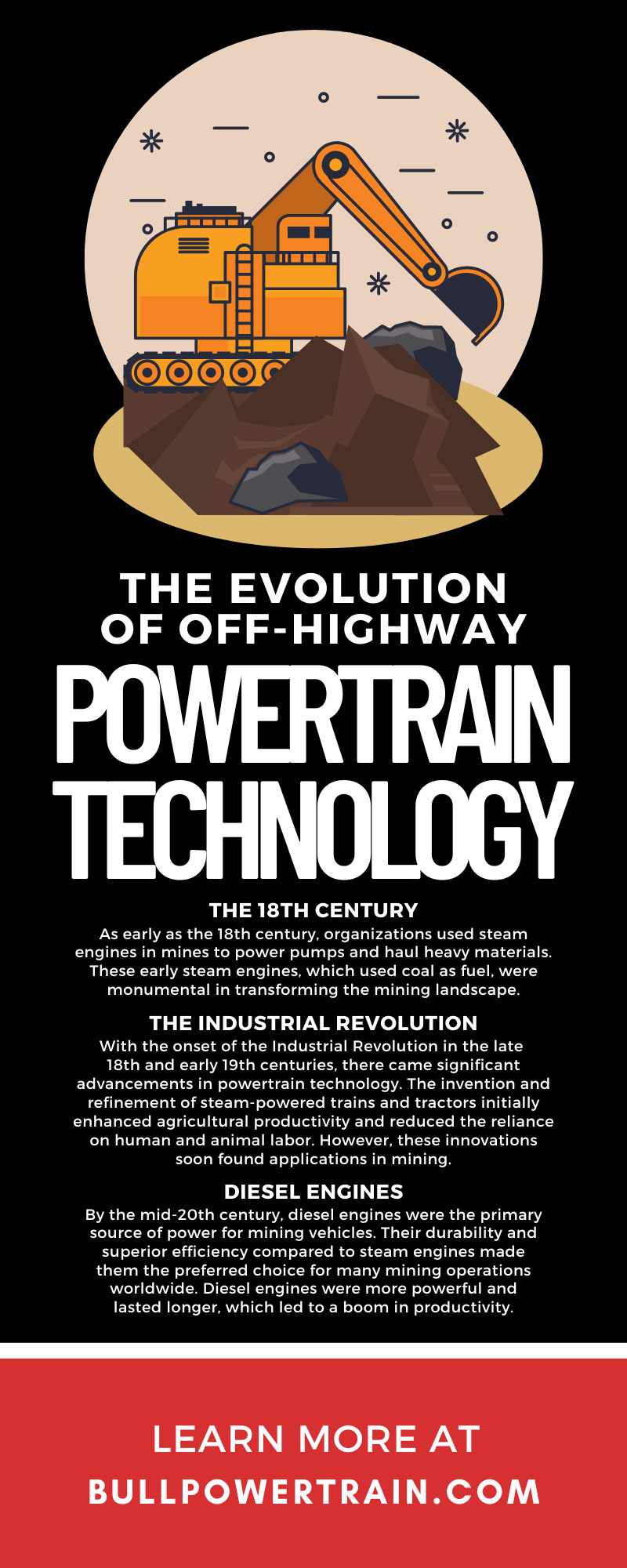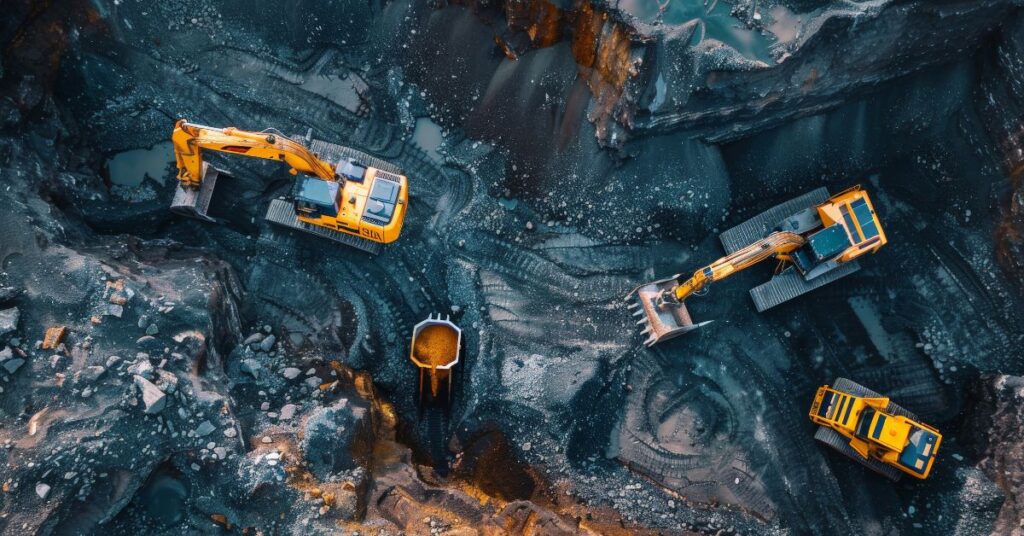In hard rock mining, off-highway powertrain technology is vital. This technology makes mining possible and safe. However, this technology didn’t come from nowhere. There’s been a lot of off-highway powertrain technology evolution over time, with lots of innovation and advancements along the way. This technology has grown a lot and will only continue advancing, so before it advances anymore, you must develop a good understanding to better make use of this technology in your operation.
The 18th Century
You may not realize it, but off-highway powertrain technology has been around for centuries. As early as the 18th century, organizations used steam engines in mines to power pumps and haul heavy materials. These early steam engines, which used coal as fuel, were monumental in transforming the mining landscape.
This innovation revolutionized the mining industry by allowing for deeper excavation and more efficient material handling while also paving the way for future advancements. Steam engines could handle significant loads efficiently, marking the beginning of a more industrialized approach to mining.
The Industrial Revolution
With the onset of the Industrial Revolution in the late 18th and early 19th centuries, there came significant advancements in powertrain technology. The invention and refinement of steam-powered trains and tractors initially enhanced agricultural productivity and reduced the reliance on human and animal labor. However, these innovations soon found applications in mining.
Adapted steam-powered mining vehicles allowed for the more efficient transportation of mined materials, significantly boosting the speed and scale of mining operations. In this period, mining rail systems became popular as well, able to move large amounts of ore and other resources. These technologies increased mining output and efficiency.
Diesel Engines
By the mid-20th century, diesel engines were the primary source of power for mining vehicles. Their durability and superior efficiency compared to steam engines made them the preferred choice for many mining operations worldwide. Diesel engines were more powerful and lasted longer, which led to a boom in productivity.
This transformation also allowed for the use of larger and more powerful machinery, such as haul trucks and excavation equipment. Diesel engines made it possible to operate these machines for longer periods without needing to refuel. The use of diesel engines also led to the standardization of mining equipment, enhancing efficiency and safety across the entire industry.
Electric-Powered Mining Vehicles
The 1970s marked a significant shift toward more environmentally friendly power sources. Electric-powered mining vehicles became popular in this decade as there was a greater awareness of environmental issues in the industrial world. Electric vehicles, which use batteries or connect to an external power source, reduce greenhouse gas emissions and lower operational costs by eliminating the need for fossil fuels.
These vehicles contributed to cleaner mining practices by reducing both noise and air pollution. Additionally, these vehicles set the stage for future technological development, pushing for further research into energy sources and battery technology.
Hybrid Powertrains
During the same period, hybrid powertrains also emerged, combining traditional diesel engines with electric motors. This innovative approach came about with the need to improve fuel efficiency and reduce emissions. Hybrid powertrains brought a more sustainable approach to powering mining vehicles, balancing robust performance with environmental considerations. These systems allowed vehicles to switch seamlessly between diesel and electric power or use both simultaneously, optimizing fuel consumption and minimizing harmful emissions.
More Sophisticated Control Systems
As technology continued to advance throughout the late 20th century, more sophisticated control systems became the norm. These systems improved performance and safety while also enabling operators to maintain more precise control over vehicle operations in challenging environments. Some common features of these systems include:
- Automated braking
- Enhanced steering precision
- Stability control
The introduction of advanced control mechanisms significantly reduced the risk of accidents and enhanced operational efficiency, making mining vehicles safer and more reliable.
Alternative Fuel Sources
Emissions have always been a concern in the mining industry, and around the early 2000s, there was a great shift in attention toward alternative fuel sources. Some sources that many operations considered include:
- Natural gas
- Biodiesel
- Hydrogen fuel cells
These alternatives offered more sustainable options and reduced the industry’s reliance on traditional fossil fuels. The exploration and adoption of these new fuels further pushed the boundaries of powertrain technology, promoting a greener mining industry. Additionally, the use of alternative fuels helped mining companies comply with stricter environmental regulations and meet the growing demand for sustainable practices.
Autonomous Operations
With the rise of automation in the mining industry, powertrain technology has evolved even further to support autonomous operations. These advancements have allowed mining vehicles to operate with minimal human intervention, increasing efficiency and reducing labor costs.
By using sophisticated sensors and AI algorithms, these autonomous vehicles can perform tasks with high precision. High-quality autonomous vehicles ensure consistent performance even in hazardous conditions.
Telematics, Telematics, Telematics
The integration of advanced telematics systems into powertrains has enabled real-time monitoring and diagnostics of mining vehicles. This technology allows operators to track vehicle performance, identify potential issues before they become critical, and perform timely maintenance. The ability to monitor vehicles in real time has significantly reduced downtime and boosted productivity. When you can see parameters like engine health and fuel consumption, you can further optimize operations and plan maintenance schedules.
Powertrain Technology of Today
Today, mining companies are heavily investing in fully electric and autonomous vehicles that can operate continuously without the need for a human driver. These state-of-the-art vehicles maximize productivity while minimizing environmental impact and operational costs. The integration of advanced robotics, AI, and sophisticated sensors ensures that these vehicles can handle complex tasks and challenging terrains with precision and reliability. Without operators, these vehicles can work around the cloud without the limitations and safety risks that come with human fatigue.
The Future
Off-highway powertrain technology has come a long way, and it will only continue to advance as there are additional innovations in renewable energy, fuel cell technology, and data analytics. These developments will further enhance the sustainability, efficiency, and safety of mining operations. The mining industry will see a more innovative and environmentally conscious future driven by technological progress and a commitment to sustainability. This technology is important now, but it will only become even more important as the demand for minerals and resources grows even more in the ever-growing technological world.
The evolution of off-highway powertrain technology has been a remarkable journey driven by constant innovation and technological advancements. The future is bright in this industry, and here at Bull Powertrain, we’re here to make that transition into the future easy with our off-highway powertrain services. Whether you need a repair, upgrade, or a complete rebuild, we’re the reliable off-highway mining equipment supplier you can count on!


